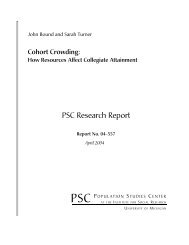Tracking metropolitan America into the 21st century - Population ...
Tracking metropolitan America into the 21st century - Population ...
Tracking metropolitan America into the 21st century - Population ...
You also want an ePaper? Increase the reach of your titles
YUMPU automatically turns print PDFs into web optimized ePapers that Google loves.
IntroductionThe term “<strong>metropolitan</strong> area” isone of <strong>the</strong> few statisticalterms that is also familiar incommon conversation. A <strong>metropolitan</strong>area is not a political jurisdictionwith a mayor or policedepartment, but ra<strong>the</strong>r an economicallyand socially linked collection oflarge and small communities. Residingin a <strong>metropolitan</strong> area provides identificationwith a well understoodbroader community, often elicitingcivic pride promoted by local chambersof commerce and economicdevelopment commissions. Regionalnewspapers, sports teams and culturalinstitutions all serve to reify <strong>the</strong> existenceof <strong>the</strong> <strong>metropolitan</strong> area. Moreover,<strong>the</strong> <strong>metropolitan</strong> designation ofan area confers on it something of anurbane or cosmopolitan status, placingit in a league with o<strong>the</strong>r areas as a recognizedeconomic region.Such commonly-held perceptions of<strong>metropolitan</strong> areas are reflected in rigorousstatistical definitions of <strong>the</strong> <strong>metropolitan</strong>concept, developed by <strong>the</strong>federal government’s Office of Managementand Budget (OMB). Federalagencies such as <strong>the</strong> U.S. CensusBureau use <strong>the</strong>se standards to collectand disseminate area-based statisticsin publications such as <strong>the</strong> UnitedStates Statistical Abstract. They areincorporated <strong>into</strong> federal and statepolicies to allocate public resources tolocal areas. They are also used widelyin <strong>the</strong> private sector and <strong>the</strong> researchcommunity to identify consumer markets,labor markets, and housing markets.And OMB-defined <strong>metropolitan</strong>areas are often ranked in <strong>the</strong> popularpress and publications such as <strong>the</strong>Places Rated Almanac.The federal government defined<strong>metropolitan</strong> statistical areas as earlyas <strong>the</strong> late 1940s, 1 and has updated<strong>the</strong>m several times, primarily to take<strong>into</strong> account shifts in demographictrends and modest changes in nomenclature.2 However, in <strong>the</strong> early 1990sFigure 1. Old versus New TerminologyOLDConsolidated Metropolitan Statistical Area (CMSA)Primary Metropolitan Statistical Area (PMSA)Metropolitan Statistical Area (MSA)Central CityNew England County Metropolitan Area (NECMA)NEWMetropolitan Statistical Area (MetroSA)Micropolitan Statistical Area (MicroSA)Combined Statistical Area (CSA)Metropolitan DivisionPrincipal CityNew England City and Town Area (NECTA)Source: OMBOMB initiated a decade-long effort toreassess <strong>the</strong> <strong>metropolitan</strong> classificationsystem, in light of <strong>the</strong> manychanges in U.S. settlement patternsthat had taken place over <strong>the</strong> previous50 years. 3The original <strong>metropolitan</strong> statisticalarea concept was predicated on <strong>the</strong>model of a large central city of over50,000 residents that served as a hubof social and economic activity for surroundingcounties. Toge<strong>the</strong>r, <strong>the</strong> cityand counties formed a stand-alone<strong>metropolitan</strong> area. Over <strong>the</strong> past fivedecades, however, <strong>the</strong> decentralizationof both employment and population inmany urban areas have served to disperse<strong>the</strong> “core” well beyond <strong>the</strong>largest city <strong>into</strong> smaller clusters of previously“suburban” communities. As<strong>metropolitan</strong> populations expanded, itbecame evident that hierarchies wereforming within <strong>metropolitan</strong> areas.Large <strong>metropolitan</strong> areas developedsomewhat self-contained sub-areas(e.g., Newark or Long Island within<strong>the</strong> greater New York region); andexisting, neighboring <strong>metropolitan</strong>areas became, for some purposes, partof a larger super-region (e.g., Washington,D.C. and Baltimore). It alsobecame apparent that many communities,considered too small to be part ofa <strong>metropolitan</strong> area, should none<strong>the</strong>lessbe recognized as part of <strong>the</strong> settlementsystem, ra<strong>the</strong>r than be omittedcompletely.After a series of commissioned studies,convenings with user communities,and interagency meetings, OMB’swide-ranging effort in <strong>the</strong> 1990sresulted in <strong>the</strong> adoption of <strong>the</strong> newstandards for <strong>metropolitan</strong> andmicropolitan areas. OMB has urged allfederal agencies that collect and publishdata for <strong>the</strong>se areas to use <strong>the</strong>most recent definitions.The changes are quite significant,not only in terminology, but also in <strong>the</strong>geographic sweep of classified areas,(Figure 1). Figure 2 displays <strong>the</strong> <strong>metropolitan</strong>or non<strong>metropolitan</strong> status ofU.S. counties according to <strong>the</strong> old andnew standards. Under <strong>the</strong> old system,only 20 percent of <strong>the</strong> country’s territorywas defined. The new standardsdouble <strong>the</strong> coverage, classifying 46percent of U.S. land area. Micropolitanareas—a new classification—account for most of <strong>the</strong> increasedcoverage and fill in a noticeable portionof <strong>the</strong> “empty” space across <strong>the</strong>country.Given <strong>the</strong>se significant changes,2November 2004 • The Brookings InstitutionThe Living Cities Census Series















